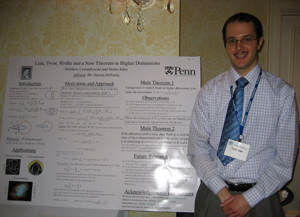Research by math and physics major Matthew Lewandowski, C’09, and math major Stefan Sabo, C’10, was honored with an award in the Undergraduate Poster Session of the 2009 Joint Mathematics Meetings of the American Mathematical Society and the Mathematical Association of America. The two students spent the past year working with Dennis DeTurck, Professor of Mathematics and Dean of the College of Arts and Sciences, on a project about Calugareanu’s theorem, which defines properties of how curves twist and knot around one another.
The theorem’s validity has long been established for curves in three-dimensional spaces, and has been applied to understanding subjects as varied as DNA’s double-helix structure and the wrapping and coiling magnetic field lines of the Crab Nebula. Lewandowski and Sabo were able to generalize this theorem so that it holds true in higher dimensional spaces, and they also discovered that it works differently in even-dimensional spaces than in odd-dimensional ones.
Their findings are now being used in research on hyperbolic, or curved, spaces by a team of scholars including DeTurck and math professor Herman Gluck. “The version of the theorem that Stefan and Matt proved takes place in ‘ordinary’ or Euclidean space,” DeTurck says. “We're now working on writing up the generalization of their results to various curved spaces that arise in relativity and in other settings.”
"I'll graduate next year, and I've even taken some graduate-level classes, but it really made me see how much there is out there that I still want to know." - Stefan Sabo
Sabo had a chance to present the findings in a well-received talk at Argonne National Laboratory in Chicago last November. He and Lewandowski then submitted a proposal to present at the student poster session of the Joint AMS-MAA Meetings, which took place in Washington last month. “They worked hard,” DeTurck says, “using the resources in the Weigle Information Commons in Van Pelt Library, to produce a professional-grade poster. I’m pleased, but not surprised, that their work was recognized by a poster session prize.”
Lewandowski and Sabo—who both plan to continue on in academia after graduating—also valued the opportunity to experience one of the premier conferences in the field. More than 5,500 mathematicians attended the Joint AMS-MAA Meetings, which provide an opportunity for scholars in all fields of mathematics to present talks and participate in panels on topics ranging from new approaches to unsolved theoretical problems to cutting-edge applications of math to issues such as climate change, finance, medicine and improving math education.
“I got a really good idea of what research at this level looks like and of the problems people are working on,” says Lewandowski, who recently received a Thouron Award to pursue graduate study in the United Kingdom next year.
Both students freely admit that they couldn’t fully understand the high-level scholarship presented at many of the talks they attended, but Sabo believes even this experience was inspiring. “It was very humbling,” he says. “I’ll graduate next year, and I’ve even taken some graduate-level classes, but it really made me see how much there is out there that I still want to know.”



